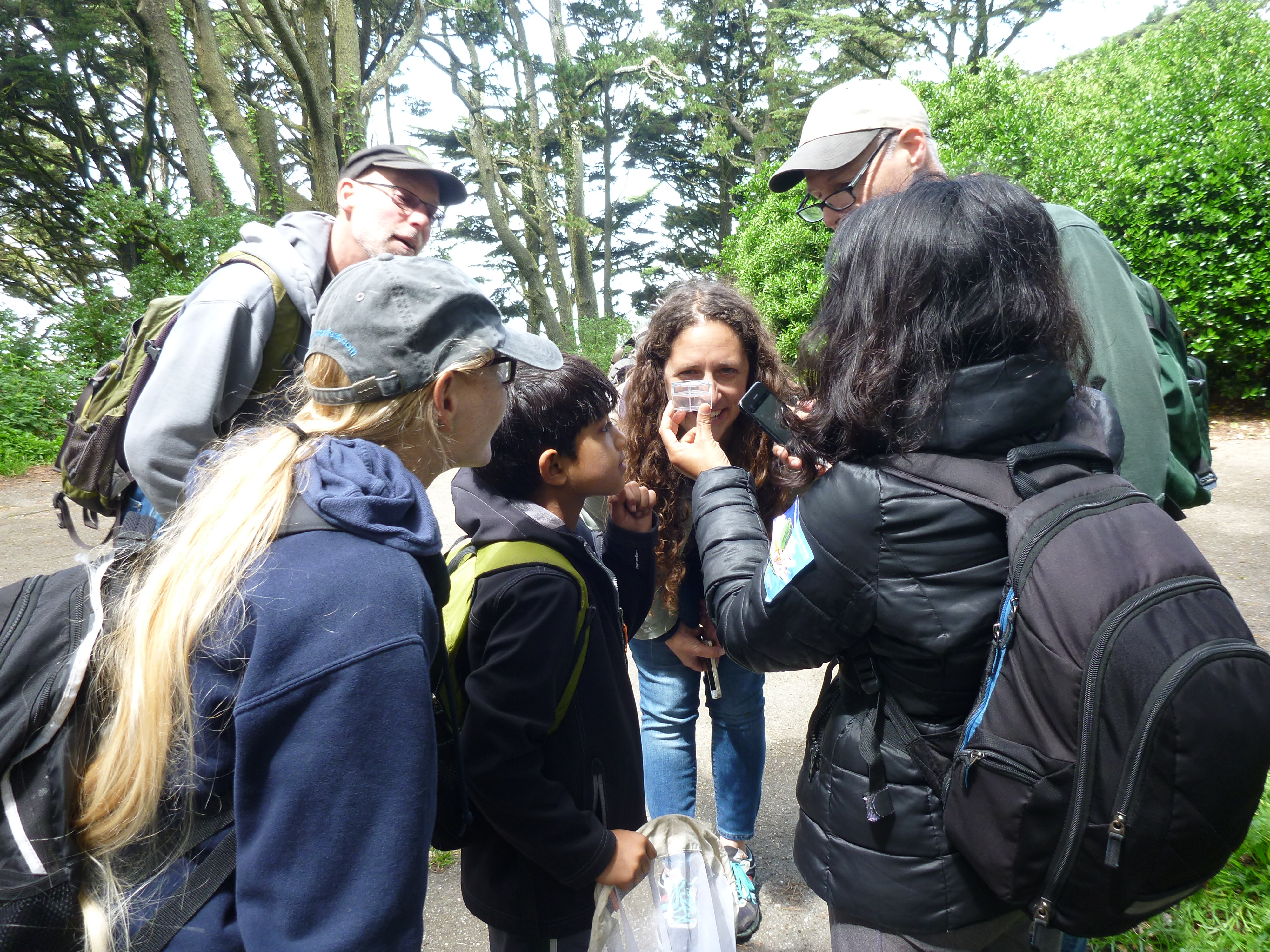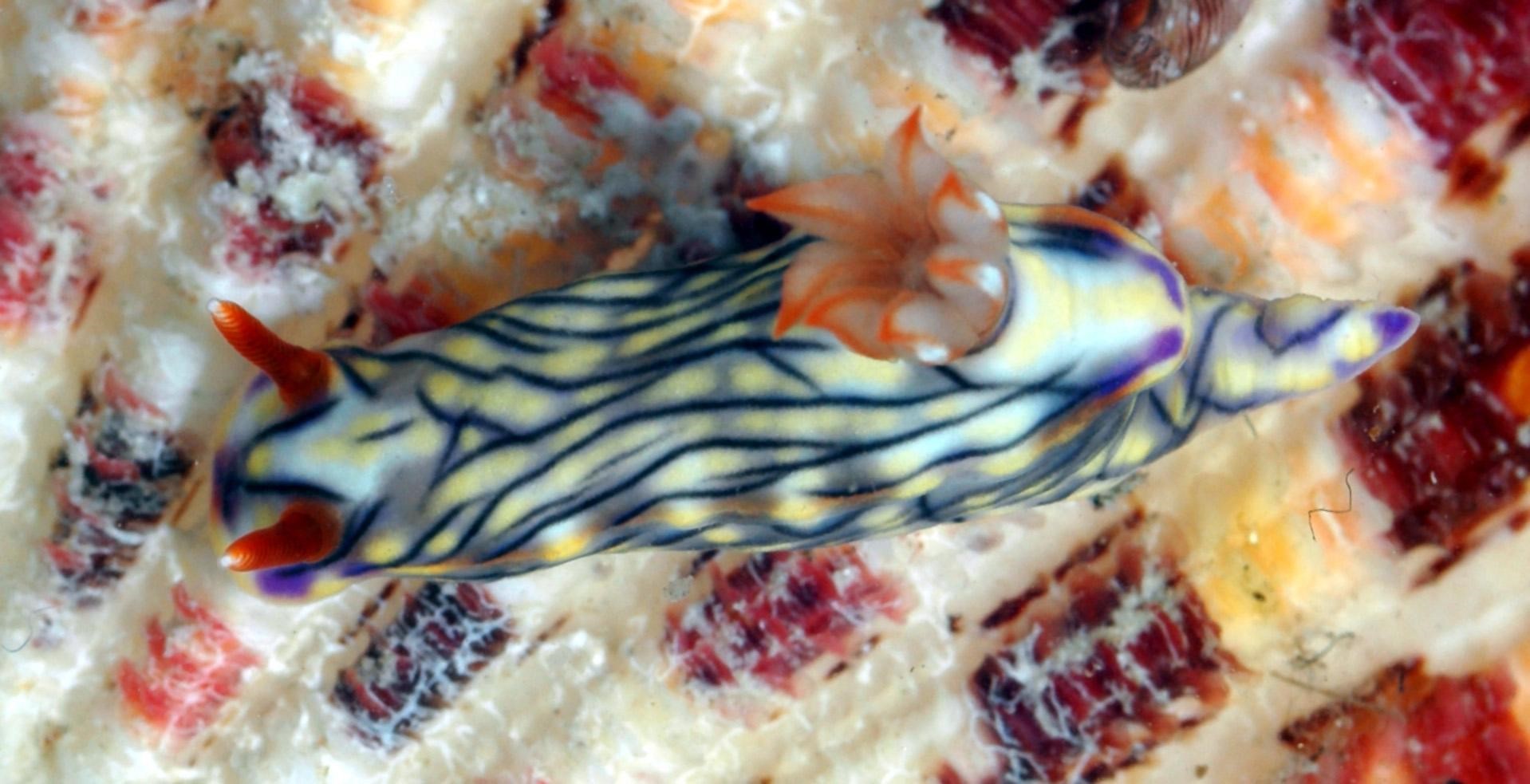#MySciComm: Rebecca Johnson on citizen science, building community, and discovering together through #scicomm
This week, Rebecca Johnson responds to the #MySciComm questions!

Rebecca Johnson (center) examines a discovery made by volunteers during a bioblitz in San Francisco. (Photo by Alison Young)
Rebecca co-directs the Citizen Science program at the California Academy of Sciences. She holds a PhD in biology (ecology and evolutionary biology) from the University of California, Santa Cruz where she studied the evolution of color pattern in chromodorid nudibranchs (really beautiful sea slugs). She combines historical museum collections data and current observational data to understand climate and land use change. Her core work at Cal Academy is building and facilitating a community of naturalists working together to discover nature, in special places and in their everyday lives. Connect with her @rebafay or @rebeccafay on iNaturalist.
The #MySciComm series features a host of SciComm professionals. We’re looking for more contributors, so please get in touch if you’d like to write a post!
————————-
Okay, Rebecca…
1) How did you get into the kind of SciComm that you do?
I have my dream job. I spend about ⅓ of my time in nature, ⅓ in a natural history museum, and the other ⅓ in meetings with awesome partners talking about how to make the first ⅔ more meaningful.
I organize people’s curiosity, knowledge, enthusiasm, and desire to make a difference into meaningful science and conservation.
Looking back, I can make sense of the path that led me here, but I never imagined this is where I would end up. I grew up in the chaparral suburban matrix between Los Angeles and Santa Barbara. I was raised by civically active parents. They always encouraged me to explore the world and think of how to use my talents to make the world better.
Professionally, I grew up at the California Academy of Sciences, a natural history museum in San Francisco. I came to the museum as a 22 year-old intern, and my task was to describe a new nudibranch species I had discovered during a field course.

Hypsleodoris zephrya – The new sea slug (marine snail without a shell) species discovered by Rebecca in French Polynesia in 1994; pictured specimen is from Vanuatu (Photo by T. Gosliner)
I’d been in French Polynesia, as an undergraduate at the University of California, Berkeley, when I found the beautiful slug that came to be named, Hypselodoris zephyra. This project eventually became the basis for my Master’s thesis at San Francisco State University and led to this paper describing 12 new species of Hypselodoris and building a family tree of the group. I came to the museum to study nudibranch systematics. At that time, I didn’t fully appreciate the role natural history museum research had on the public-facing parts of the institution, like the exhibits, dioramas, and our aquarium.
As I continued on through two graduate degrees, embedded in the Invertebrate Zoology & Geology Department at the Academy, I found opportunities to talk with museum guests about my work. I loved working as a teaching assistant, especially in the field and in Invertebrate Zoology labs. I found that I had the most challenging and interesting conversations about my research in small groups and one on one. And I found studying some of the most beautiful animals in the world (see above) was a great way to draw people in.
I was hooked on connecting to people in a more informal setting.
I got better every time I put myself out there. I discovered four keys to informal education: be prepared, be yourself, ask questions, and listen. Communicating science is a conversation and every conversation is a chance to explain something a little better. I changed my strategy with every new person depending on what was interesting to them. I learned that I could frame my story a bit differently for each person. I could use different analogies. This was a critical discovery for me because everyone comes from a different starting place. By asking and listening, I found a way to connect to almost everyone.
All of my research, teaching, and informal science communication experience converged six years ago when I got the opportunity to shape a new iteration of Cal Academy citizen science program with my friend and colleague Alison Young. Together with an amazing team, including the folks from iNaturalist, we crafted a discovery program. We facilitate opportunities for people from all walks of life to discover nature all around us. Our program combines biodiversity exploration with civic engagement. We build communities working together to document nature for science and conservation.
I cannot think of a better way to communicate my science than to build opportunities for everyone to do it with me.
I recently had a full-circle moment when one of our high-school volunteers, together with her mom, discovered a species of nudibranch never before seen in North America. The daughter was the sole author on the paper detailing their find.
Like me over twenty years earlier, the student was empowered by a supportive community of fellow naturalists that helped her learn the nudibranchs and identify her find. Only this time, the discovery was made in the San Francisco Bay, not a tropical island thousands of miles away. They shared their find immediately on the social network iNaturalist. The community that supported them was a combination of professional scientists and amateur experts-one that I had help create and support. For me, making space for everyone’s expertise in my science, making it our science is the accomplishment of which I am most proud.
Everyday, I get to build a corps of naturalists and empower them to notice nature around them. I communicate and share my science with them.
I also get to mobilize their expertise and introduce them to tools for sharing their science with the world. Through this process, together we make a difference locally and globally.
2) What are your top 3 SciComm tips and/or resources?
1. Listen and ask questions. And when you do, respect other’s experience and expertise.
Next time someone asks you about your work, ask them a few questions before you start into your elevator speech. Then think about what parts of your story will ‘stick’ with them.
And, find great communicators. Read and listen to other folks communicating science.
On Twitter, I love @grrlscientist, @edyong209, @astrokatie, @jacquelyngil, @Tessa_M_Hill, @duffy_ma, @hormiga, and @HopeJahren.
Also look outside science for folks who communicate their expertise well, whatever it may be, and learn from them.
2. Social media is fabulous, but don’t sacrifice the person-to-person interactions.
Like many of the other #MySciComm contributors, I find the COMPASS message box a useful tool to help craft the stories I want to tell. Once I have the core messages and supporting ideas, I can better shift them while preserving my intended focus. The compass tool works in preparing for all kinds of interactions and venues. I find twitter and social media critical to my work because they allow me to reach a lot of people a one time, promote events, and connect with new people-but remember to do those things face to face too!
3. Don’t be afraid to show enthusiasm for what you do and what you love. A great way to do this is get interviewed.
Good journalists ask the best questions and talking with them has really helped me think about how I tell stories. Don’t know how to start?
- There are some amazing opportunities to connect with new audiences, like http://www.skypeascientist.com/.
- Does your university have a journalism school? Go ask if any journalism students need to practice interviewing.
- Giving public lectures is also a great way to meet writers and other professional science communicators. Although meant for philosophers, there are some really fabulous suggestions in “So you want to be a public philosopher” by Carrie Jenkins.
- I have also had a few journalists take classes I have taught about natural history and tidepools, like Mary Ellen Hannibal (@mehannibal). Because our citizen science events are public and open to anyone, I have even met journalists, like Eric Simons (@ericsimons), while exploring nature together!
Put yourself out there, take risks, and share your story.